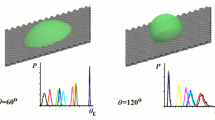Abstract
A stochastic model for metastable wetting of roughness-induced hydrophobic surfaces is proposed. For a rough surface, increased solid–liquid interface area results in increased interface energy, and increases the contact angle (for non-wetting liquids) or decreases it (for wetting liquids). For a very rough surface, a composite solid–liquid–air interface may form with air pockets trapped in the valleys between asperities, as opposed to the homogeneous solid–liquid interface. Both the homogeneous and composite interface configurations correspond to local energy minima of the system and therefore, there are stable states associated with different energy levels. The system may transform from one stable state to the other due to small perturbations, such as capillary waves. Different probabilities are associated with these different stable states, depending on the energy levels. The contact zone consists of a large number of asperities and valleys, which may be in the homogeneous or composite state. The overall contact angle is calculated based on the statistical model. The model may be used for design of roughness-induced superhydrophobic surfaces.






Similar content being viewed by others
References
Adamson AV (1990) Physical chemistry of surfaces. Wiley, NY
Bhushan B (1998) Tribology issues and opportunities in MEMS. Kluwer Academic Publishers, Dordrecht
Bhushan B (2002) Introduction to tribology. Wiley, NY
Bhushan B (2004) Springer handbook of nanotechnology. Springer-Verlag, Heidelberg
Bhushan B, Israelachvili JN, Landman U (1995) Nanotribology: friction, wear and lubrication at the atomic scale. Nature 374:607–616
Cassie A, Baxter S (1944) Wettability of porous surfaces. Trans Faraday Soc 40:546–551
Erbil HY, Demirel AL, Avci Y (2003) Transformation of a simple lastic into a superhydrophobic surface. Science 299:1377–1380
Extrand CW (2002) Model for contact angles and hysteresis on rough and ultraphobic surfaces. Langmuir 18:7991–7999
Eyring H (1964) Statistical mechanics and dynamics. Wiley, New York
Israelachvili JN (1992) Intermolecular and surface forces, 2nd edn. Academic Press, London
Johnson RE, Dettre RH (1964) Contact angle hysteresis. In: Fowkes FM (ed) Contact angle, wettability, and adhesion advanced chemical series, vol 43. American Chemical Society, Washington, DC, pp 112–135
Landau L, Lifshitz E (1959) Fluid mechanics. Pergamon Press, London
Marmur A (2003) Wetting on hydrophobic rough surfaces: to be heterogeneous or not to be? Langmuir 19:8343–8348
Neinhuis C, Barthlott W (1997) Characterization and distribution of water-repellent, self-cleaning plant surfaces. Ann Bot 79:667–677
Nosonovsky M, Bhushan B (2005) Roughness optimization for biomimetic superhydrophobic surfaces. Microsyst Technol 11:535–549
Patankar NA (2003) On the modeling of hydrophobic contact angles on rough surfaces. Langmuir 19:1249–1253
Shibuichi S, Onda T, Satoh N, Tsujii K (1996) Super-water-repellent surfaces resulting from fractal structure. J Phys Chem 100:19512–19517
Wenzel RN (1936) Resistance of solid surfaces to wetting by water. Ind Eng Chem 28:988–994
Yost FG, Michael JR, Eisenmann ET (1995) Extensive wetting due to roughness. Acta Metall Mater 45:299–305
Author information
Authors and Affiliations
Corresponding author
Rights and permissions
About this article
Cite this article
Nosonovsky, M., Bhushan, B. Stochastic model for metastable wetting of roughness-induced superhydrophobic surfaces. Microsyst Technol 12, 231–237 (2006). https://doi.org/10.1007/s00542-005-0048-0
Received:
Accepted:
Published:
Issue Date:
DOI: https://doi.org/10.1007/s00542-005-0048-0




